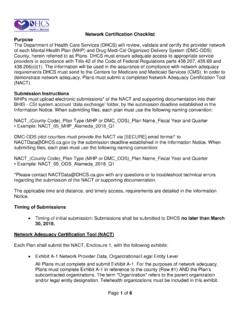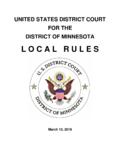Transcription of Changes to US Patent Practice - Oliff PLC
1 2007 Oliff & Berridge, PLC Changes TO Patent Practice FOR LIMITATIONS ON CLAIMS, CLAIM FEES, RELATED APPLICATIONS AND APPLICATIONS CONTAINING PATENTABLY INDISTINCT CLAIMS, CONTINUING APPLICATIONS, AND REQUESTS FOR CONTINUED EXAMINATION August 31, 2007 I. Introduction On August 21, 2007 the United States Patent and Trademark Office (USPTO) published New Rules regarding (1) limitations on claims in applications, (2) claim fees, including retroactive increases in claim fees, (3) "related" applications and applications containing patentably indistinct claims, (4) continuing (continuation, continuation-in-part (CIP) and divisional) applications, and (5) Requests for Continued Examination (RCE).
2 The New Rules include significant Changes to Patent Practice that affect Patent applications meeting certain specified criteria. This Special Report summarizes the New Rules, interprets the effects of the rule Changes , and offers recommendations to be considered in filing and prosecuting new and continuing applications in the United States in view of these New Rules. The general effective date for these New Rules is November 1, 2007. Applicants are cautioned, however, that provisions of the New Rules affect (1) applications currently on file, including identification requirements for "related" (commonly owned with at least one common inventor) applications that must be satisfied by February 1, 2008, (2) certain submissions between August 21, 2007 and November 1, 2007, and (3) new and continuing applications filed on or after November 1, 2007.
3 These differing provisions will be discussed in detail throughout this Special Report. Proposed rule Changes were published for comment in early 2006. The USPTO broadly identified, as justification for sweeping rule Changes in the above-identified areas, a need to (1) reduce the use of its examining resources in an effort to reduce examination delays, and (2) reduce the backlog of unexamined Patent applications. The proposed rule Changes were viewed by many as misguided, not likely to achieve the USPTO's objectives, and, in part, contrary to controlling law. Further, the proposed rule Changes were viewed as excessive even to address the asserted objectives, and prejudicial to Applicants' rights and financial interests.
4 Our firm, as well as hundreds of other groups and individuals involved in Patent Practice , provided the USPTO with significant comments regarding the flaws and adverse consequences of the proposed rule Changes . In response to some of the comments from the Patent community, the USPTO revised a number of the proposed rules, and generated additional rules. For those familiar with the proposed rule Changes , it will become apparent that the New Rules are somewhat less strict than those that were proposed, particularly with regard to continuing applications. However, they still present significant restrictions and burdens on Applicants, in many cases unsupportable by logic or by law.
5 This Special Report: (1) provides in Part II an overview of what we currently consider the most significant Changes brought about by the New Rules, (2) provides in Part III a detailed discussion of the New Rules with annotations to the specific provisions of the New Rules for ease of reference, (3) provides in Part IV recommendations that Applicants may wish to consider in light of the New Rules for actions that may be applicable immediately, and for actions that will affect prosecution decisions under the August 31, 2007 2 2007 Oliff & Berridge, PLC New Rules after November 1, 2007, (4)
6 Provides in Appendix A a Schedule of Effective Dates for differing provisions of the New Rules, (5) provides in Appendix B a New Rules Checklist of items to consider that simplifies an Applicant's decisions regarding implementation of the New Rules, and (6) provides in Appendix C a copy of the New Rules, in their entirety. We do not attach the entire USPTO commentary regarding the New Rules, which is over 100 pages long. However, the full commentary is available on our website at in the "News & Events" section. As an additional resource, the USPTO indicates that it is receiving many inquiries regarding the New Rules.
7 The USPTO is posting the questions with answers on the USPTO web site. The USPTO indicates that it anticipates updating this information weekly at < >. We would be delighted to respond with written inquiries or schedule a personal meeting or a telephonic or video conference with you to discuss the New Rules and how they will affect preparation and prosecution of Patent applications. For ease of reference in view of the complexity of the New Rules and the consequent length of this Special Report, a Table of Contents for this Special Report is provided below. August 31, 2007 3 2007 Oliff & Berridge, PLC Table of Contents I.
8 Introduction .. 1 II. Overview .. 6 A. Limitations on Claims in Applications .. 6 B. Effects on Claim Fees .. 6 C. Refunds Of Excess Claim Fees .. 7 D. Identifying "Related" Applications Having One or More Common Inventors and Common 7 E. Presumption regarding Indistinct Claims In Separate Applications .. 7 F. Limitations on Number of Continuation and CIP 7 G. Limitations on Number of RCEs .. 7 H. Special Treatment regarding Divisional Applications .. 7 I. Miscellaneous New Rules Provisions .. 7 III. Detailed Discussion of New Rules .. 8 A.
9 Limitations on Claims in Applications .. 8 1. Overview .. 8 2. Required Actions .. 8 3. Notice .. 8 4. Patent Term Adjustment .. 8 5. Differing Effective Dates .. 8 6. Effect of Withdrawn 8 7. Effect of "Related" Applications .. 8 8. Examination Support Document (ESD) .. 9 9. Supplemental 10 10-12. Miscellaneous 10 13. Effective Dates .. 10 B. Effects on Claim Fees.
10 10 1. Independent/Dependent 10 2. Multiple Dependent 10 3. Effective Dates .. 11 C. Refunds Of Excess Claim Fees .. 11 1. Canceled Claims .. 11 2. Withdrawn 11 3. Abandoning International 11 4. Effective Date .. 11 August 31, 2007 4 2007 Oliff & Berridge, PLC D. Identifying "Related" Applications Having One or More Common Inventors and Common 11 1.





